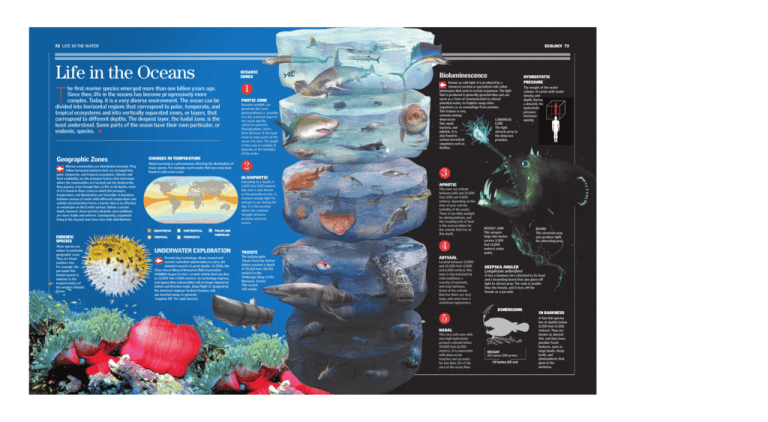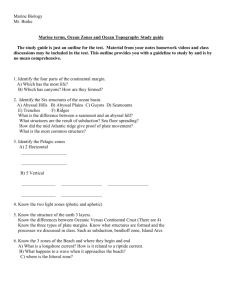Life in the Oceans
advertisement

72 LIFE IN THE WATER ECOLOGY 73 Life in the Oceans OCEANIC ZONES T he first marine species emerged more than one billion years ago. Since then, life in the oceans has become pr ogressively more complex. Today, it is a very diverse environment. The ocean can be divided into horizontal regions that correspond to polar, temperate, and tropical ecosystems and into vertically separated zones, or layers, that correspond to different depths. The deepest layer, the hadal zone, is the least understood. Some parts of the ocean have their own particular, or endemic, species. Geographic Zones Marine communities are distributed unevenly. They follow horizontal patterns that are arranged into polar, temperate, and tropical ecosystems. Climate and food availability are the principal factors that determine where the communities are located and the biodiversity they possess. Even though there is life at all depths, most of it is found in those zones in which the pressure, temperature, and illumination are favorable. A boundary between masses of water with different temperature and salinity characteristics forms a barrier that is as effective as mountains on the Earth’s surface. Below a certain depth, however, these barriers diminish, and conditions are more stable and uniform. Consequently, organisms living in the abyssal zone have very wide distributions. ENDEMIC SPECIES These species are unique to particular geographic areas. They are found nowhere else. For example, the porcupine fish Diodon hystrix is endemic to the tropical waters of the western Atlantic Ocean. CHANGES IN TEMPERATURE Global warming is a phenomenon affecting the distribution of many species. For example, warm-water fish have now been found in cold ocean zones. 1 PHOTIC ZONE Because sunlight can penetrate this zone, photosynthesis is possible. It is the warmest layer of the ocean and the richest in nutrients. Phytoplankton, which form the base of the food chain in many parts of the ocean, live here. The depth of this zone is variable; it depends on the turbidity of the water. 2 OLIGOPHOTIC Extending to a depth of 1,600 feet (500 meters), this zone is also known as the penumbral zone. It receives enough light for animals to see during the day. It is the location where the constant struggle between predator and prey occurs. EQUATORIAL SUBTROPICAL TROPICAL TEMPERATE POLAR AND SUBPOLAR UNDERWATER EXPLORATION Present-day technology allows crewed and remote-controlled submersibles to carry out detailed research at great depths. In 2006, the China Ocean Mineral Resources R&D Association (COMRA) began to test a crewed vehicle that can dive to 23,000 feet (7,000 meters). As technology imprves, next-generation submersibles will no longer depend on ballast and flotation tanks. Deep Flight II, designed by the American engineer Graham Hawkes, will use inverted wings to generate “negative lift” for rapid descent. TRIESTE The bathyscaphe Trieste from the United States reached a depth of 35,810 feet (10,916 meters) in the Challenger Deep of the Marianas Trench. This record still stands. Bioluminescence Known as cold light, it is pr oduced by a chemical reaction in specialized cells called photocytes that exist in certain organisms. The light that is produced is generally greenish-blue and can serve as a form of communication to attract potential mates, to frighten away other organisms, or as camouflage from enemies. This feature is very common among deep-ocean LUMINOUS fish, squid, LURE bacteria, and The light jellyfish. It is attracts prey to also found in the deep-sea various terrestrial predator. organisms such as fireflies. HYDROSTATIC PRESSURE The weight of the water column. It varies with water density and depth. During a descent, the hydrostatic pressure increases quickly. 3 APHOTIC This zone can extend between 650 and 13,000 feet (200 and 4,000 meters), depending on the time of year and the turbidity of the water. There is too little sunlight for photosynthesis, and the resulting lack of food is the main problem for the animals that live at this depth. 4 DEADLY JAW This weapon helps this hunter survive 3,300 feet (1,000 meters) under water. BEARD This structure may also produce light for attracting prey. ABYSSAL Located between 13,000 and 26,000 feet (3,000 and 6,000 meters), this zone is characterized by cold conditions, a scarcity of nutrients, and total darkness. Some of the animals that live there are very large, and some have a monstrous appearance. DEEPSEA ANGLER Linophryne arborifera It has a luminous lure attached to its head and a branching beard that also gives off light to attract prey. The male is smaller than the female, and it lives off the female as a parasite. DIMENSIONS 5 HADAL This very cold zone with very high hydrostatic pressure extends below 20,000 feet (6,000 meters). It is associated with deep-ocean trenches and accounts for less than 2% of the area of the ocean floor. WEIGHT 10.5 ounces (300 grams) 3.9 inches (10 cm) IN DARKNESS A few fish species live at depths below 8,200 feet (2,500 meters). They are known as abyssal fish, and they have peculiar facial features, such as large heads, sharp teeth, and photospheres that glow in the darkness.





